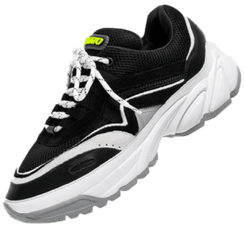Not sure how to use Instagram for business? Well, it’s time that someone teaches you the best ways to use the app for your professional venture.
Why Instagram? Because the platform offers tons of ways for ecommerce merchants to find and connect with potential customers. And with a suite of targeting and advertising options, you can choose exactly which of those billion users you want to get in front of.
Interested in using Instagram for your small business? We’ll tackle everything you need to get started below.
What is Instagram and How is It Used?
Let’s first go over Instagram for beginners: It’s a visually focused social media network and app that allows users and brands to share photo and video content with their followers. It started out as simply a photo-sharing app, and has since evolved into a multimedia platform with paid advertisements, Stories self-destructing messages, and live broadcasts through IGTV.
It’s a great place for brands to connect with consumers, leveraging a platform with 1.074 million users across the globe.

The demographics of Instagram are interesting too. It’s almost evenly split among male and female users, though the audience is mostly between 25 and 34 years old. If this is a group you’re looking to reach, Instagram is one channel to do it with.
How to Download Instagram
To download the Instagram app, go to the Google Play Store or Apple App Store (depending on your device’s operating system). You can download the app for free. When you open it for the first time, you’ll be prompted to create a new account.
Types of Instagram Posts
If you’re keen to promote your business on Instagram, it’s helpful to familiarize yourself with the type of content you can post. There are several kinds of Instagram posts you can throw into your content mix:
- Organic: These can be photos, videos, or galleries of visuals. This shows in your followers’ feeds, on any hashtags you include in the copy, and potentially in the Explore section (Instagram controls this).
- Stories: 500 million Instagram accounts use Stories every day, and one-third of the most-viewed Stories are from brands, not people.

- Influencer posts: Though it seems consumers have caught on to influencers’ ways, influencer marketing is still very much a plausible tactic. These posts are either shared on influencers’ feeds or your brand’s (or both), enabling you to reach a new audience and add credibility in the form of social proof.
- IGTV: IGTV is one of the newer features for Instagram. This is used for long-form video content — you can broadcast live and the video will live on your profile after the live event has ended.
- Ads: One billion is a big number, and chances are, not everyone who’s on Instagram is going to be a target customer. When you use Instagram ads, you can set parameters for who is shown your ads, making sure they fit your ideal profile.
How to Create an Instagram Business Account?
If you want to know how to use Instagram marketing for your business, creating a company account is a practical first step. Here are the steps to turn your regular account into corporate Instagram account:
Instagram Profile Tutorial for Business
- Go to your Instagram profile and tap the menu at the top right corner.
- Choose “Settings” and see if you can switch to a professional account from this menu. If you can’t, tap Account > Business.
- Sync your Facebook business and Instagram accounts if you need to by following the instructions on the screen.
- Pick a business category and enter contact details.
- Add more details about your business in the given fields, then tap Done.
Congrats! You’ve created an Instagram business page. Now spend some time optimizing it so that it attracts your target audience towards your business.
How to Optimize Your Instagram Business Account
Optimize Your Instagram Bio
There are several ways to market your business on Instagram, including promoting via your Instagram bio. Your bio is a bit of text where you share a bit about your brand, who is behind the account, and what to expect from following your account.
You’ll also see your brand’s description, profile photo (use your company logo to build brand recognition), and link (you can use a “link in bio” tool like Linkpop) in your Instagram bio.
It’s also a good idea to reiterate some of your unique selling points in your bio to encourage trust and drive conversions. And if you operate at a brick-and-mortar location, remember to include the address so shoppers can easily find you.
Take a peak at high-end jewelry brand Claurete’s Instagram bio, for example:
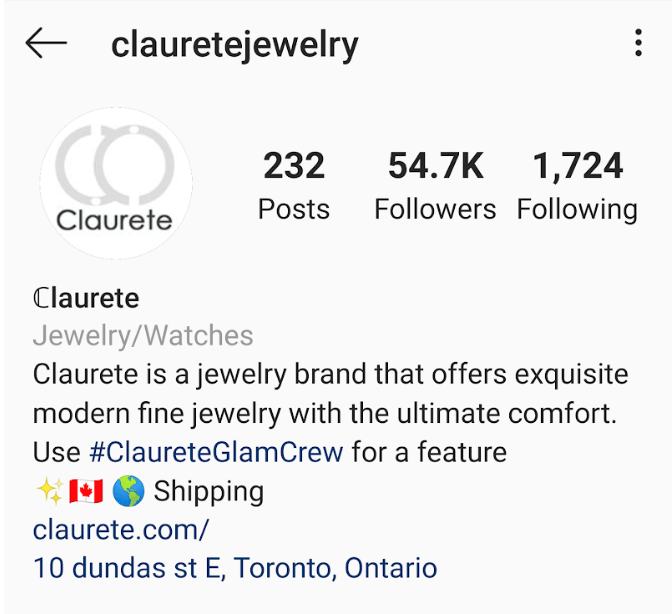
You can update your bio link as often as you want. It should go to your website, a landing page, product page, or somewhere else on your site. If you’re linking to a specific page about a sale, for example, post a photo related to the sale and update your bio link. It’s a common practice for brands on Instagram.
Launch an Instagram Shop
If you’re selling online, you can also launch your Instagram with a store. Your Instagram Shop is another ecommerce channel where customers can purchase your product from within the Instagram interface. This makes it easier to get them to convert, as they don’t have to go through the process of leaving the app, visiting your site, and going through the purchase process.
Here’s an example of an Instagram Shop from MVMT watches:
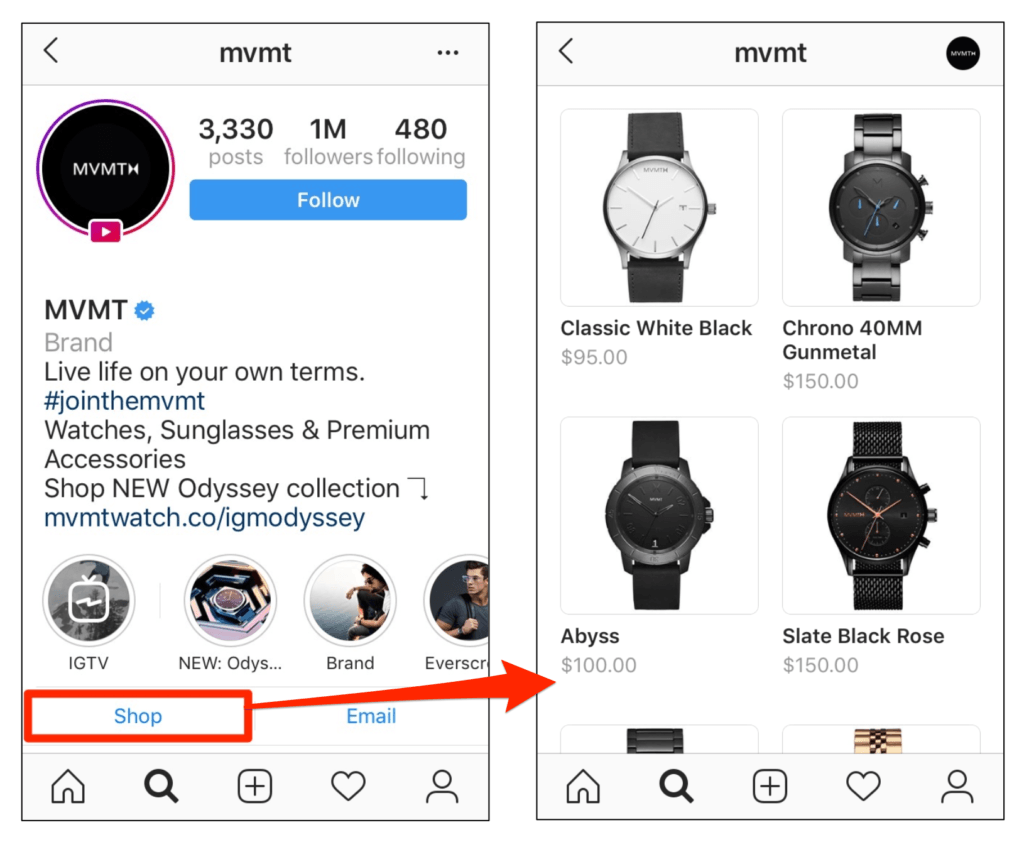
What to Post on Instagram: Creating Your Content Strategy
Instagram is all about branding. It’s important to develop a cohesive feed of product photos, lifestyle imagery, user-generated content (UGC), Instagram shoutouts, and other visuals that bring your brand persona to life. If you’re selling sunglasses, post photos of people on sunny beach holidays wearing your products or place a pair amidst other outfits and accessories fit for adventures your audience might want to go on.
Before we get too into the weeds, the best way to kick off any marketing effort for your business is with a goal-driven, strategy-first approach. Your Instagram strategy should define:
- Your Instagram goals (make sure these support overarching marketing and business goals)
- Specific KPIs you’ll look at to determine performance
- Who you’re targeting on Instagram
- What content you’re going to post on Instagram
- Who’s managing the account and creating the content for Instagram
Over time, you’ll learn a lot, especially how to choose content to post on Instagram to help you meet your goals. Ask yourself, “why do people use Instagram?” and why they follow brands, and then develop a strategy centered around your audience (instead of your sales goals).
How to Get Followers for Your Instagram Business Page
As you grow your feed, always keep the primary goal in mind: building a following to help generate more sales. This often requires a long-term, strategic approach.
One way to grow your following beyond creating engaging content is by following other accounts with audiences that might also be interested in your brand. The best method to find Instagrams to follow is in the ‘Discover’ section of the app. Other Instagram businesses to follow could include brands similar or complementary to yours.
Sticking with our sunglasses example, you might want to grow your network by following beach clothing brands or influencers who might wear sunglasses like yours. Being strategic about who you follow is also one of the best ways to siphon followers from your competitors by going to their accounts and adding some of their followers.
Build relationships with your audience by giving a follow back to the accounts that follow you. Remember, just a follow isn’t enough. Be sure to like and comment on other profiles, too. Engagement is as important, if not more, than the initial act of following.
Results won’t come overnight! Be patient and keep combing Instagram for the right accounts to feed your network on the site, and over time you will begin to see results.
When and How Often to Post on Instagram
As mentioned above, in comparison to other marketing channels like Facebook, knowing how often to post on Instagram takes on its own unique strategy.
Posting at least once a day is a good benchmark, but anything ranging from 4–5 a week or even a couple of posts a day is acceptable. The main thing? Keep it consistent and focused on high-quality content.
Note that data suggests there isn’t really any limit in how often to post on Instagram, so it’s best to test and see what works for you. A solid place to start is to post once or twice a day and adjust from there.
So when is the best time to post on Instagram? This really depends on a few key factors: where you’re located, where your audience is located, and what your audience’s Instagram habits are. A good rule of thumb is to post during lunch (between 11 a.m. and 1 p.m.) and in the evening (between 7 p.m. and 9 p.m.) The best days? Monday, Wednesday, and Thursday. Sunday is generally the worst day to post.
How to Promote Your Business on Instagram
Post Photos and Videos
You need to consider how your photos (or video) are going to look. What are you capturing in the frame? How will it appear on a mobile device? Will it showcase the product details that you want front-and-center? Does it match your brand aesthetic? Remember, you’re curating an entire feed, so it’s important that visuals are cohesive.
For instance, if you’re only selling t-shirts, it’s going to be inconsistent for you to share a photo of coats, shoes, or accessories. You can also specifically exclude items that you know don’t make sense for your account. If you look at American Giant’s Instagram posts, you can see the synergy between them all:
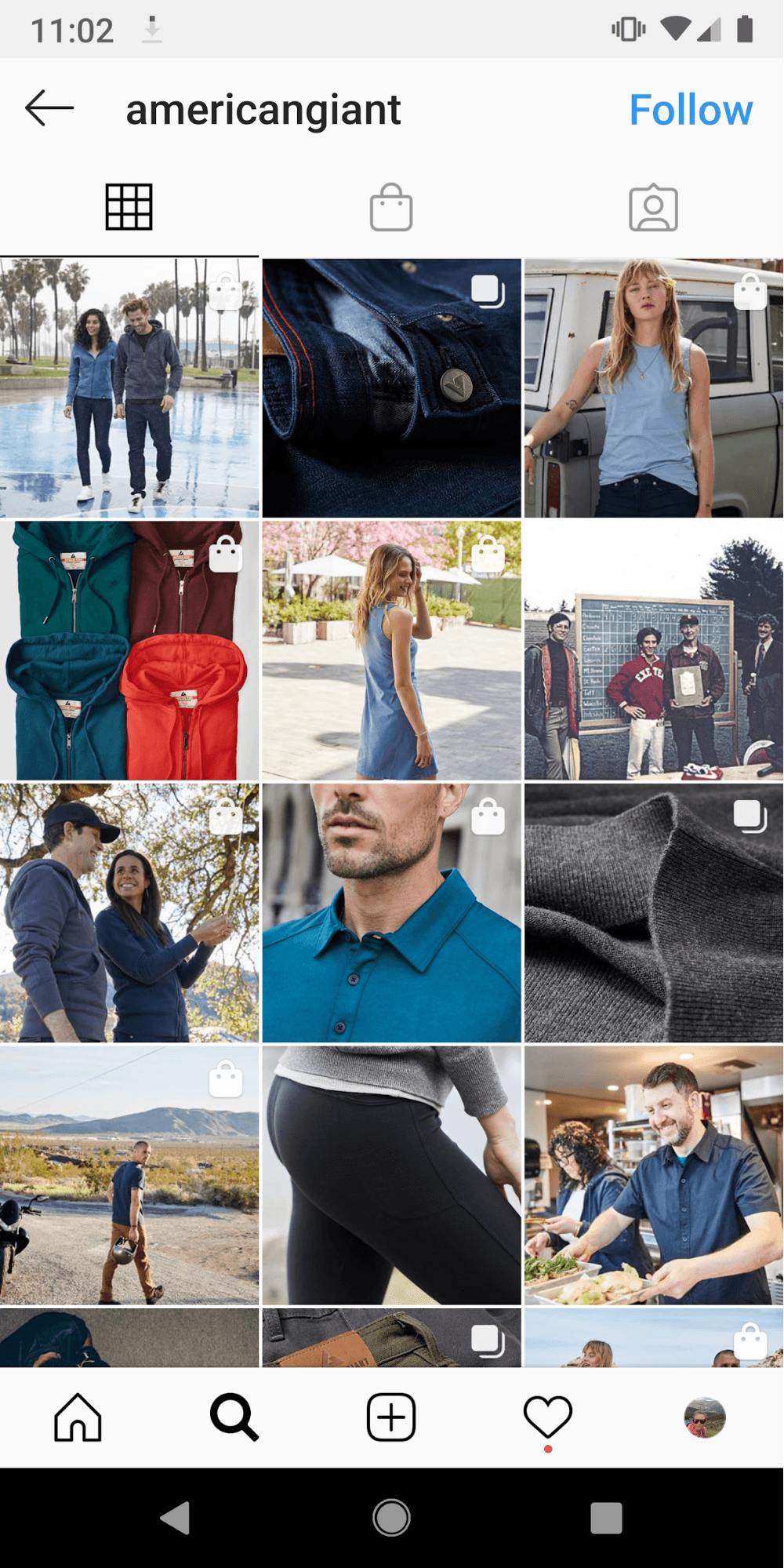
Pick a Color Palette and Font
Having a color palette can help you create the synergy we’re talking about. This doesn’t mean you can only post content that’s completely approved colors. But everything should match a similar aesthetic and be complementary of one another, rather than a hapless hodge podge of posts.
Instagram has built-in filters that you can use to adjust the look and feel of your posts. This includes sepia, black-and-white, and several other effects. Generally speaking, it’s best to apply filters outside of the app in your own photo-editing software, so that you can apply this to visual assets when not posting to Instagram too.
You should also pick a font to use for your posts. This includes font type, style, and point size. It’s most likely going to be the same font on your website, to create synergy among different channels for increased brand recognition.
Leverage Captions
Your visual content is only half of it. Each post gets room for an Instagram caption too. You get up to 2,200 characters (or approximately 330 words) to play with. You want to get creative here, too.
Captions should be easy to read and on-brand. If your brand uses humor, be funny in your captions. If you’re a luxury brand, sophistication is key. Don’t be afraid to experiment with emojis either. These can be playful and conversational, perfect for social media.
Just like with your visuals, captions also need to be on-brand and consistent. While your tone might change, it’s important that you remain true to your overarching brand voice. Consistency is crucial in today’s omnichannel world.
The last thing on the list is hashtags. Consistently including hashtags in the description or comments section of your posts is a key strategy for boosting the engagement on your account. As users click a given hashtag, they head to an entirely different feed with every post that includes that hashtag. This means that your posts become discoverable to new audiences who may not already interact with your account.
To determine which hashtags to use, check your competitors, influencers in your niche, and the hashtags your followers use.
Toysmith includes hashtags on their posts:
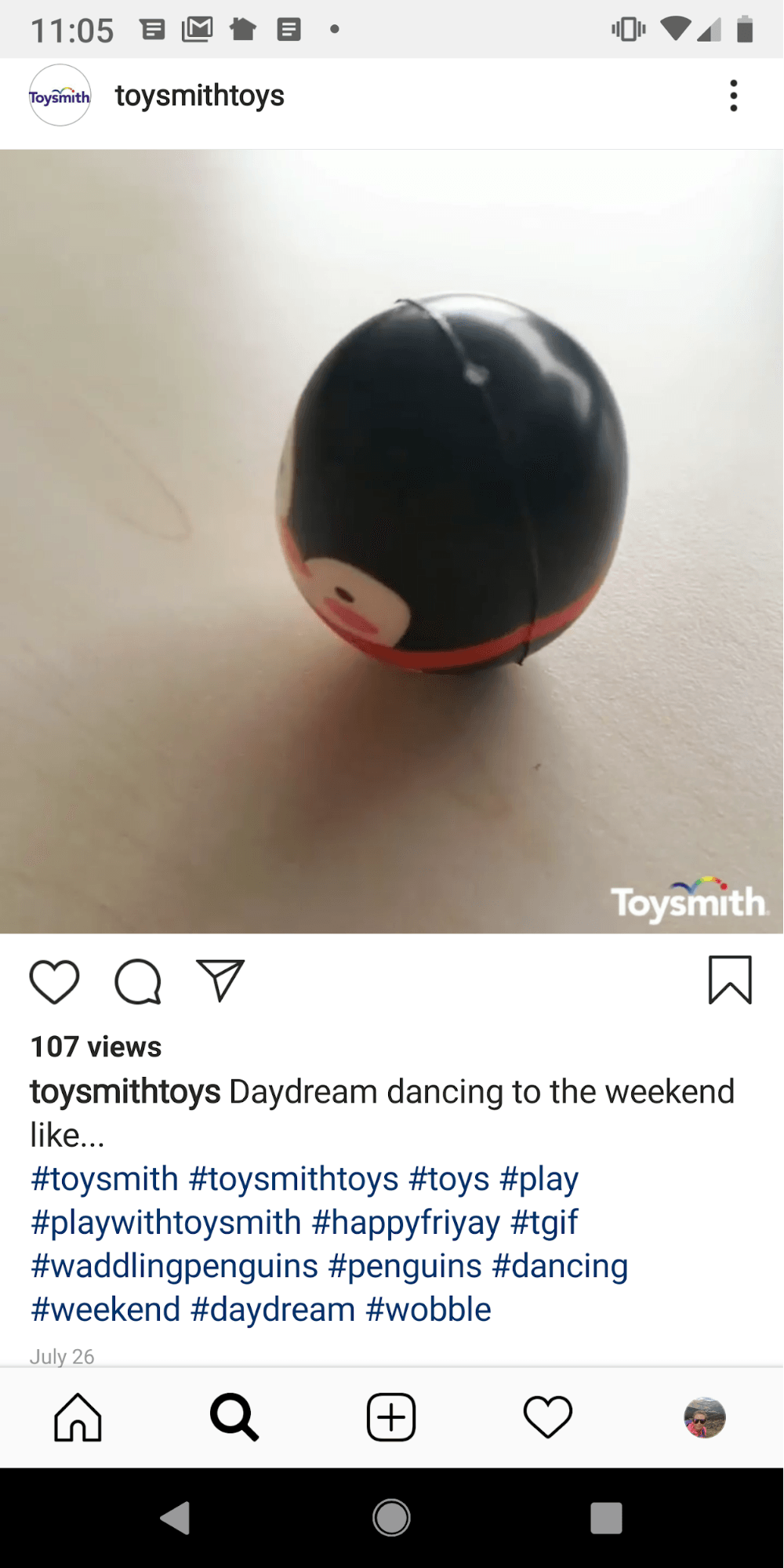
Run Paid Ads on Instagram
In addition to growing your following organically, you can also create paid ads on Instagram. The ads will appear in your targeted audience’s newsfeed just as pictures and videos of the accounts they follow do. Choose a single photo or video to highlight a specific product or promote a collection with a gallery. You can also promote ads in Instagram Stories.
All you need to get started with creating your paid ads on Instagram is a Facebook Ads account to add the channel from your Business Manager page. From here, things operate on the same system as Facebook ads.
Tracking Your Progress on Instagram
As with anything in marketing, it’s absolutely essential to track your progress over time and make adjustments to improve performance.
Some KPIs to think about on Instagram include:
- Followers: total, growth, etc.
- Engagement: likes, comments, reposts, views, etc.
- Visibility: impressions, reach, etc.
- Conversions: clickthroughs, referral traffic, sales, etc.
Knowing the proportion of people who view your profile in comparison to the number of followers you get can also be beneficial in determining whether or not you need to up your engagement in order to make more followers out of the people who are only viewing your profile.
Summary: How to Start a Business on Instagram in 2021
Now you have the building blocks for deciding how to use Instagram for business. Be patient and give yourself the time you need to turn your account into a revenue-driving machine.
- Start by setting up your account with your username handle, profile photo, Instagram bio, and link with tracking parameters.
- Create a content strategy to help inform your Instagram content calendar, publishing cadence, hashtags, and targeting.
- Remember to follow and engage with other accounts, especially in the beginning.
- Build a following organically and then experiment with targeted Instagram ads to reach your intended audience.
- Don’t forget to track your performance over time. Optimization is key to making sure you’re generating the most ROI for your efforts.
If you have any comments, questions, or experiences using Instagram for your dropshipping business, feel free to share in the comments section below!

